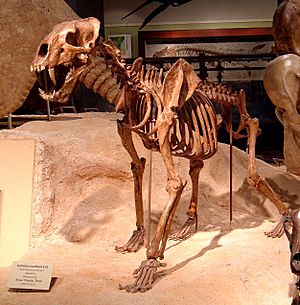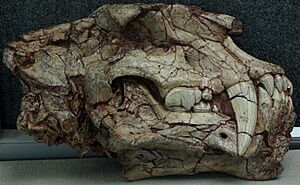Homotherium facts for kids
Quick facts for kids Homotherium |
|
|---|---|
 |
|
| Skeleton of H. serum from Friesenhahn cave, Texas Memorial Museum, University of Texas at Austin, Austin, Texas. | |
| Scientific classification |
|
| Kingdom: | Animalia |
| Phylum: | Chordata |
| Class: | Mammalia |
| Order: | Carnivora |
| Suborder: | Feliformia |
| Family: | Felidae |
| Subfamily: | †Machairodontinae |
| Tribe: | †Homotherini |
| Genus: | †Homotherium Fabrini, 1890 |
| Type species | |
| Homotherium latidens Owen, 1846
|
|
| Other species | |
|
|
Homotherium was a type of saber–toothed cat that is now extinct. These amazing big cats lived a long time ago. Their teeth were longer than a modern tiger's. But they were shorter than the teeth of another famous saber-toothed cat, Smilodon. Because of their curved teeth, Homotherium cats are often called "scimitar-toothed cats."
These powerful cats lived all over the world. You could find them in North America, South America, Europe, Asia, and Africa. They roamed the Earth during the Pliocene and Pleistocene epochs. This was a very long time ago, from about 5 million years ago to just 10,000 years ago.
Homotherium disappeared from Africa about 1.5 million years ago. In Eurasia (Europe and Asia), they survived until about 30,000 years ago. In South America, we have only found a few bones in northern parts like Venezuela. The very last Homotherium cats might have lived in North America until about 10,000 years ago.
Contents
How Homotherium Lived and Hunted
Scientists learn about Homotherium from studying their skeletons. Their teeth tell us a lot about how they hunted. Unlike Smilodon, which might have slashed its prey, Homotherium's canines seem to have been used for a stabbing action.
These cats had very strong front bodies. This suggests they were good at ambush hunting. They would hide and then suddenly attack their prey. This kind of hunting works best in woodlands, which were common during the Pliocene and Pleistocene.
Special Features of Homotherium
The skull of Homotherium had some unique features. Their front teeth, called incisors, were much bigger than those of modern cats. They stuck out in front of the long canines. These big incisors probably helped them hold onto and pull their prey. The molars at the back, used for slicing meat, were also huge.
Homotherium had fairly long legs. Their front legs were even longer than their back legs. They also had a short tail and a short lower back. All these features show that Homotherium was a very strong animal. It could wrestle with large prey.
Scientists think Homotherium had features like both hyaenas and modern big cats. They could ambush hunt, but also chase prey over long distances at a steady speed. They likely lived in open woodlands.
Hunting Large Prey
It's thought that these saber-toothed cats would jump onto the neck of their prey. They would hold on tightly with their strong front legs. Then, they would use their long teeth to bite into the prey's neck. Their canines were strong enough to go through the thick skin of large mammals. Modern lions, on the other hand, usually have to suffocate their prey.
Scientists have found Homotherium skeletons near the bones of mammoths, mastodons, and rhinoceros. This suggests that young elephants or rhinos might have been part of their diet!
Images for kids
See also
 In Spanish: Homotherium para niños
In Spanish: Homotherium para niños





